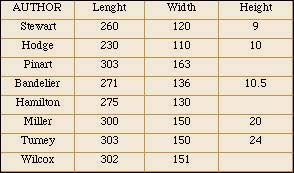|
Pueblo Grande Platform Mound, A Labor Investment Analysis © 1998 by James Q. Jacobs
Various authors have estimated and/or directly surveyed the size of the Pueblo Grande platform mound. Their results are shown in Table 1 following.
These are sequenced by time, with the later authors last. The last three roughly concur at a size of 300 x 150 feet, the size also published at the museum interpretation. Therefore these figures are used herein. Miller's and Turney's estimates of the height include wall heights. Given their mean of 22 feet, less seven feet for walls, a mound elevation of 15 feet is arrived at. The volume is therefore 450,000 cubic feet.
The entire perimeter of the mound has a 3-4 feet thick stone retaining wall. This is about 9.2 percent of the volume. Additional stone walls are found in the core. It is not apparent at the site how many of these occur. From the area where they are in evidence an estimate of the percentage can be extrapolated. Also, site interpretations infer that two mounds were joined into one. This fact also adds to the amount of original exterior retaining walls. In conclusion I estimate the stone and stone walls to be 18 percent of the mound's total mass.
The total volume estimate is 450,000 cubic feet. Eighteen percent of that is 81,000 cubic feet, the amount of stone. The remaining 82 percent is earthen fill; a combination of soil, ashes, ceramics pieces, and the small stones and gravels found in the local soil. This remainder of the mass totals 369,000 cubic feet. Given that the fill material was treated as adobe, to ensure hardening, 110,700 cubic feet of water would have been added. More would have been employed in stone wall construction, in the making of calinche mortar. Therefore I have increased the water needed to 120,000 cubic feet, or about 900,000 gallons.
Although the most obvious borrow pits are the nearby ballcourts, they predate the platform mound and are small by comparison. It is also likely that the earth from these digs was already employed in other constructs. An activity that was contemporaneous to the mound construction was canal maintenance. There is a large canal 150 m from the mound. The Salt River is 300 m from the mound. The Salt could have served as a source of stone. The canals could have provided soils. Water could have been delivered to the platform mound via a small branch canal. Therefore only 150 feet is estimated as the carry distance for the water. It is also possible that flotation was used in the procurement of rock and soil, perhaps on rafts or in canoes. But such activity is not in evidence. I therefore have calculated an average distance of 150 m for soil procurement and 300 m for stone procurement. The following person hours (PH) per cubic yard values are used in Figure 2: stone procurement, 5.3; stone moving, 0.71 per 100 ft.; earth procurement, 1.45; earth moving, 0.65 per 100 ft.; earthen adobe making and building, 2.0; water moving, 0.52 per 100 ft.
Labor associated with procurement, moving and building the amounts of materials estimated are shown in Table 2 following.
The total labor in person hours is estimated at 284,445 just for the construction of the platform mound. This is a total of 35,556 eight hour days of actual work time. A crew of 100 persons working an entire year could complete the platform mound if they had ten days off. Additional labor was expended in the construction of rooms atop the mound and a massive adobe wall surrounding the construct.
The amount of time expended evidences larger towns than ever before. A system of political organization that had access to hundreds of workers must have existed. Mounds are larger works than ballcourts, and the limited number of mounds in the region relative to ballcourts indicates larger frameworks of social organization. Canal systems require canal-wide organization and coordination. System management requires interconnection and stable social relations. Community well-being is dependent on continued successful maintenance and operation of the system. Evidence at Marana indicates that several communities centered on ballcourts became integrated into one, centered on the platform mound and a canal system. The platform mounds can be seen as evidencing a redefinition of social systems and community. Greater populations and wider integration made possible a social hierarchy and development of a more important and/or powerful class of people. Construction of rooms atop the platform mounds after 1250 and walled enclosure of the mounds reinforce the view of the platform mound as an elite space. The platform mounds are also surrounded by the most developed residential compounds, indicating the centrality of the mounds to the community. These factors indicate an important public or elite function for the mound complexes, such as center of a polity and government of a canal system. Certainly the platform mounds were connected to an important aspect of the lives of many Hohokam people. This much is plainly evidenced by the numbers required for the construction.
Comments from Readers. Mr. Jacobs, I saw your piece on the labor estimates
for the Pueblo Grande mound. You asked for comments and I thought
I would pass these on, hoping that they are helpful. I think the level
of effort was actually much greater than you suggest.
Cite as: http://www.jqjacobs/southwest/pueblo_grande.html Desert Farmers
on the River's Edge Pueblo Grande
Museum and Archaeological Park,
|

